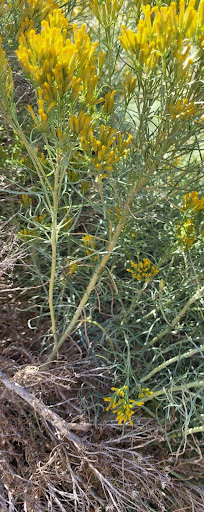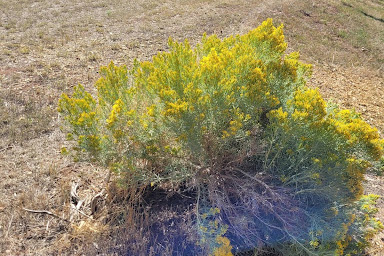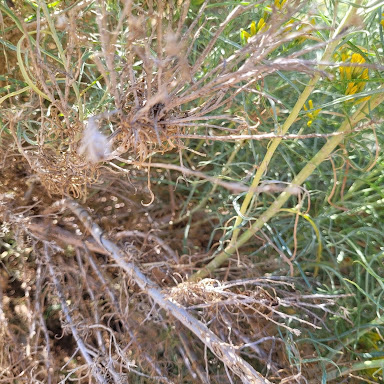Ericameria nauseosa var. speciosa
Eukaryota > Viridiplantae > Streptophyta > Streptophytina > Embryophyta > Tracheophyta > Euphyllophyta > Spermatophyta > Magnoliopsida > Mesangiospermae > eudicotyledons > Gunneridae > Pentapetalae > asterids > campanulids > Asterales > Asteraceae > Asteroideae > Astereae North American clade > Solidagininae >Ericameria > Ericameria nauseosa [1]

Ericameria nauseosa including flowers, leaves, and stems. Image by Kylee Larsen.
Plant shrub-like, typically 3-20 dm tall, with branches pointed upward; Bark covered in a tomentum; Stems white-pannose when grown on phases of saline substrates, otherwise stems grayish to green tomentose; Leaves alternately arranged, sessile, one nerved, 0.6-7 cm long by 0.5-1.5 mm wide, linear or filiform to narrowly oblong in shape; Floral inflorescences arranged heads which are numerous and form terminal paniculate cymes; Involucres 6.5-8.6 mm long; Corollas glabrous, lobes 1-2 mm long, yellow; Achenes 2.5-5.5 mm long, pilose; Ovaries pilose; 2n=18. [2]

Habit of E. nauseosa. Image by Kylee Larsen.
There are different variations within this species. The leaves of this variety can be whitish to grayish green to green in color. The plants are typically more than 3 dm tall, though can be found around 2 dm or shorter when the plant is grown on harsh substrates and may only form a dwarfed version of the variety [2]. Other varieties of the species vary in height and some may have a yellow tint of color in the branches rather than grayish green. Variety speciosa has leaves that are commonly 0.5-1.5 mm wide, where other varieties can be as wide as 3 mm. The species is taxonomically complex, and is divided into two subspecies with 22 varieties orecotypes [3] mostly based on the geographical area where the plants are found. Variety speciosa is found in saltgrass, sagebrush, pinyon-juniper, and ponderosa pine communities at 1310-2290 m in many counties across the state of Utah [2].There are differences in chemical composition between the varieties [3] but can all be identified as the species E. nauseosa.
Ericameria nauseosa can be confused with Gutierrezia sarothrae (snakeweed). Both are similar in having composite yellow flowers, but snakeweed tends to be a smaller plant with shorter leaves and shorter inflorescences; both measure to be less than 1 cm in length. Gutierrezia sarothrae also differs by having vibrant green herbage (rather than gray-green and tomentose in E. nauseosa) [4].
The Ericameria genus has a complex taxonomic history involved with its interplay with the genus Chrysothamnus, being previously known as C. nauseosus. Some botanists have recognized these two genera as completely separate, intermixed, or wholly subsumed within each other, based on morphology. Phylogenetic evidence is still needed to definitely work out the natural groupings between these genera [5]. Ericameria nauseosa was given the varietal name speciosus based on a prior publication of C. speciosus var. alicaulis [2]. Ericameria nauseosa var. speciosa can interbreed with other varieties of the species and forms intermediates or hybrids. Ericameria nauseosa var. speciosa held onto the varietal name for the aesthetic appeal this variety has where speciosa means “showy” or “good looking” [6].

Stems and bark of E. nauseosa. Image taken by Kylee Larsen.
This plant has many utilitarian uses such as brooms, brushes, baskets, dyes and arrows, and sometimes planted to serve as windbreaks. Bark has been used to make green dye and flowers to make yellow dye. Navajo tribes used this plant medicinally for coughs, colds, fever, chest pain, rheumatism, internal injuries, headache and menstrual pain [4], as well as chewing gum [3]. The Hopi weaved baskets by stripping the bark from the branches of rubber rabbitbrush. Native Americans [3].
![Distribution map of E. nauseosa at a county level [7].](/crfs/images/native-plants/plant-directory/rubberrabbitbrush-fourth.jpg)
Distribution map of E. nauseosa at a county level [7].
Although E. nauseosa is not endangered and E. nauseosa does well in repopulating disturbed areas; it is not very competitive and may eventually be replaced with other vegetation as the community matures after a disturbance [3].
Rubber rabbitbrush is common throughout the Intermountain West. The species grows in plains, valley bottoms, and foothills in association with bunchgrass, sagebrush, pinyon-juniper, and ponderosa pine communities. Rabbitbrush is frequently associated with disturbed sites and is common along roadsides throughout the western US [6]. Rubber rabbitbrush has marginal value for livestock but is an important browse species for wildlife during the winter months. Small mammals and birds such as jackrabbits and sage grouse utilize rubber rabbitbrush for cover. E. nauseosa is pollinated by a wide array of native insects, including butterflies and small bees [3].
[1] Schoch CL, et al. NCBI Taxonomy: a comprehensive update on curation, resources and tools. Database (Oxford). 2020: baaa062. PubMed: 32761142 PMC: PMC7408187;.
[2] Welsh, Stanley L., et al. A Utah Flora, Third Edition, Revised. Brigham Young University, 2016.
[3] Scheinost, P.L., J. Scianna, D.G. Ogle. 2010. Plant guide for rubber rabbitbrush (Ericameria nauseosa). USDANatural Resources Conservation Service, Pullman Plant Materials Center, Pullman, WA.
[4] Hazelton, A. (Ed.). (2016). Ericameria nauseosa. SEINet Portal Network -. Retrieved September 12, 2022, from https://swbiodiversity.org/seinet/taxa/index.php?taxon=ericameria%2Bnauseosa&formsubmit=Search%2BTerms
[5] Roberts, R. P., & Urbatsch, L. E. (2004). Molecular phylogeny of Chrysothamnus and related genera (Asteraceae, Astereae) based on nuclear ribosomal 3′ ETS and ITS sequence data. Systematic Botany, 29(1), 199-215.
[6] Buren, R. V., Cooper, J. G., Shultz, L. M., & Harper, K. T. (2011). Woody Plants of Utah. Utah State University Press.
[7] USDA, NRCS. 2022. The PLANTS Database (http://plants.usda.gov, 09/28/2022). National Plant Data Team, Greensboro, NC USA.
[8] Love, S. L., Tripepi, R. R., & Salaiz, T. (2014). Influence of harvest timing and storage interval on rabbitbrush seed germination, emergence, and viability. Native Plants Journal, 15(2), 98–108. https://doi.org/10.3368/npj.15.2.98



